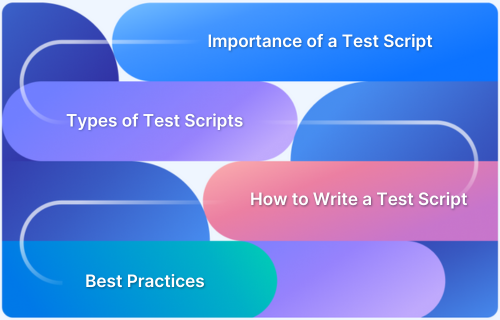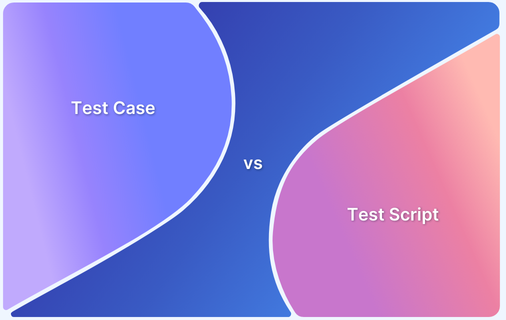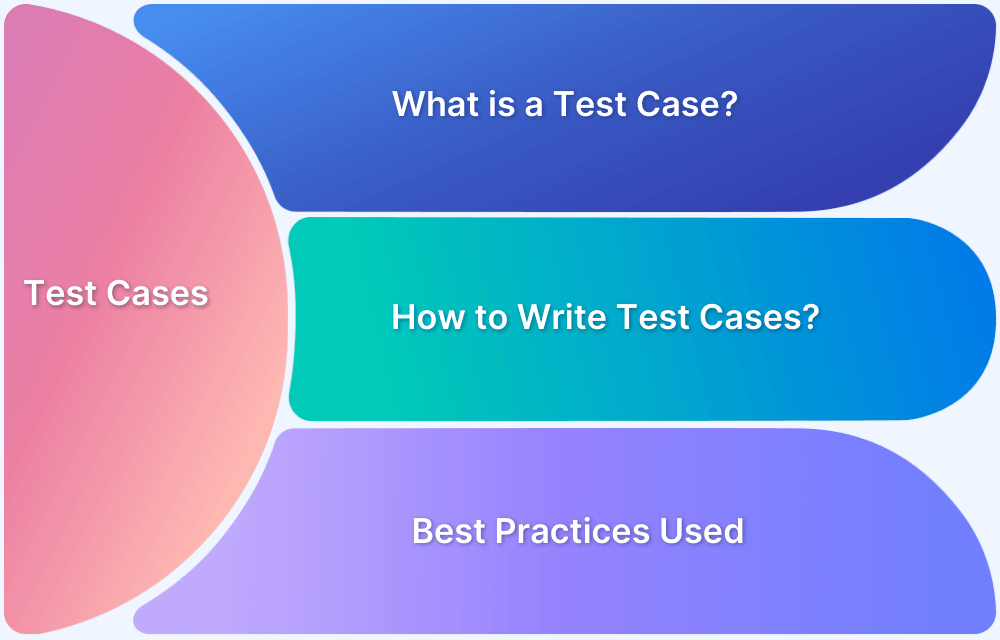Test scripts play a vital role in software testing by helping verify and assess the applications. Well-written scripts make it easier for test engineers and stakeholders to understand and validate software functionality efficiently.
Overview
What is a Test Script?
A test script is a set of instructions that verify a software application’s functionality, guiding testers or automation tools to ensure expected behavior.
Types of Test Scripts
- Manual Test Scripts: Executed by testers to uncover usability and exploratory issues.
- Automated Test Scripts: Run by tools to speed up execution and improve accuracy.
Steps to Write a Test Script
- Specify the functionality to be tested, such as user login verification.
- Select a testing tool based on the application type (e.g., Selenium for web, Appium for mobile).
- Install necessary dependencies and ensure WebDriver matches the browser version.
- Automate steps like opening the page, entering credentials, and verifying login.
- Run the test script and check test results for pass or fail messages.
This article explores test scripts, the key components, types, and best practices for effective testing.
What is a Test Script?
A test script is a set of instructions used to verify a specific functionality of a software application. It guides testers or automation tools in performing actions to check if the application behaves as expected.
- Test scripts can be manual or automated using languages like Python, Java, and JavaScript.
- They ensure consistency and efficiency across different testing environments.
- A single test case can have multiple test scripts for different conditions.
- Reusable scripts streamline testing, especially with tools like Selenium, Appium, Playwright, and Cypress.
Key Elements in a Test Script
A well-structured test script includes the following key elements:
- Script ID: A unique identifier for the test script (eg., TS001, Login_Script_01).
- Script Name: A descriptive title summarizing the script’s purpose.
- Objective: A clear statement defining the goal of the test script.
- Prerequisites: Conditions that must be met before execution.
- Test Environment: System, platform, and configuration details.
- Test Data: Input values required for execution.
- Test Steps: Detailed instructions or automated script defining the sequence of actions.
- Expected Outcome: The anticipated result after test execution.
- Actual Outcome: The observed result (filled after execution).
- Error Handling: Steps to manage exceptions or failures.
- Log and Reporting: Details on how execution logs and results are captured.
- Version Control: Information on script versions and updates.
- Author: Name of the script creator.
- Dependencies: External files or libraries required.
- Execution Time: Estimated time to run the script.
- Reusability: Whether the script can be reused for multiple test cases.
- Automation Tool: The specific tool used for execution.
Must Read: Test Case Vs Test Script
Here’s a simple example of a manual test script to test the file upload functionality for a web application.
Test Script Title: Verify that a user can upload a PDF file
Preconditions: The user must have valid login credentials (Username: User1, Password: Password1).
Test Steps:
- Open the web application in a browser.
- Log in with the username and password.
- Go to the file upload section.
- Click ‘Browse’ and select a PDF file.
- Click the ‘Upload’ button.
- Check for a success message.
Expected Result:
The PDF file should be uploaded successfully, and a confirmation message should be displayed to the user.
Importance of a Test Script
Test Script plays an important role due to the following reasons:
- Ensures Nothing is Missed: A test script provides a structured approach, ensuring all steps are followed correctly.
- Verifies User Requirements: Helps validate that the software meets specific user needs.
- Supports Exploratory Testing: Useful when testers navigate the software freely while still verifying expected outcomes.
- Reduces Errors: A well-prepared script minimizes the chances of mistakes during testing.
- Saves Time and Effort: Automating test scripts speeds up the process and reduces manual work.
- Enhances Reusability: Scripts can be reused across multiple test scenarios and environments.
- Improves Collaboration: Helps testers, developers, and stakeholders understand the testing process.
- Ensures Compliance: Maintains software quality by verifying functionalities against user requirements.
Learn More: How to ensure Reusability of Code in a Project
When to Use a Test Script
Test scripts are essential for maintaining software quality and reliability. They help streamline testing processes, ensuring accuracy and efficiency in various scenarios.
- Testing critical features: To ensure they work correctly.
- Regression testing: To check if new updates impact existing features.
- Automated testing: To efficiently run repetitive tests.
- Performance testing: To evaluate the software’s speed and stability.
- Complex test cases: That need detailed execution steps.
- Cross-device testing: To ensure compatibility across different platforms.
Learn More: How to approach Cross Platform Testing
Types of Test Scripts
Test scripts can be categorized into manual and automated testing. Each serves a specific purpose, depending on the project requirements and testing goals.
1. Manual Test Scripts
Manual test scripts are written and executed by human testers without using any automation tools. They follow a set of predefined steps to verify the software’s functionality.
It helps uncover issues that automated tests might miss and is helpful for the following types of testing:
- Exploratory Testing: Identifying unexpected issues.
- Usability Testing: Evaluating user experience.
- Ad-Hoc Testing: Performing unscripted, on-the-fly testing.
Also Read: Adhoc Testing vs Exploratory Testing
2. Automated Test Scripts
Automated test scripts are written in multiple programming languages and executed using different automation tools. They simulate user interactions and efficiently validate expected outcomes.
These automated scripts help:
- Reduce manual effort for repetitive tests.
- Increase test coverage and accuracy.
- Accelerate test execution in large-scale projects.
Subtypes of Automated Test Scripts:
- Unit Testing Scripts: Validate individual components during development.
- Integration Testing Scripts: Ensure multiple components work together.
- Functional Testing Scripts: Verify software functionality based on requirements.
- Regression Testing Scripts: Ensure existing features remain intact after updates.
- Performance Testing Scripts: Assess system performance under different loads.
- End-to-End (E2E) Testing Scripts: Test complete workflows from start to finish.
- Smoke Testing Scripts: Quickly verify core functionality after major updates.
- Security Testing Scripts: Identify vulnerabilities and security risks.
Learn More: Sanity Testing vs Smoke Testing
Who Writes a Test Script?
Test scripts are created by different professionals depending on whether the testing is manual or automated:
- Manual Test Scripts: Written by manual testers or QA analysts, these scripts provide step-by-step instructions to validate software functionality. Testers manually execute these steps to check if the application behaves as expected.
- Automated Test Scripts: Developed by automation testers or software engineers, these scripts use programming languages. They help execute tests automatically, making the process faster and more efficient.
Developers often write test scripts for unit testing. Business analysts or product managers may also contribute to defining test scenarios.
Key Approaches for Writing a Test Script
Testers use different methods to write test scripts based on project requirements, testing scope, and available tools.
Some of the most common approaches are:
1. Record and Play Approach
This is one of the simplest ways to create test scripts and requires minimal coding effort.
- The tester records user actions performed on the application, such as clicking buttons, entering text, and navigating through pages.
- The recorded actions are automatically converted into a test script, which can be played back to execute the same steps.
- Testers may need to modify the generated script to correct errors or adjust test parameters.
- This approach is helpful for quickly creating test scripts but may not be flexible enough for complex scenarios.
- Commonly used with automation tools like Selenium IDE and UFT (Unified Functional Testing).
2. Keyword/Data-Driven Testing Approach
This approach separates test design from test execution, making it easier for testers without programming skills to write test scripts.
- Keyword-Driven Testing: Testers describe test steps using predefined keywords (such as Click, EnterText, and Verify).
- Data-Driven Testing: Test scripts pull input data from external sources like Excel, CSV, or databases, allowing multiple test scenarios to run with different data sets.
- Developers create automation scripts that recognize and execute these keywords.
- This method is suitable for large-scale automation since changes in test data do not require modifying the script.
- Tools like Selenium WebDriver (with TestNG) and Appium support both keyword and data-driven testing.
3. Programming-Based Approach
In this approach, test scripts are manually written using any programming language. It provides the highest level of flexibility and control over test execution.
- Testers write test scripts using Python, Java, JavaScript or C#.
- These scripts can interact with web elements, perform validations, and handle test logic dynamically.
- Test scripts can be integrated into automation frameworks like Selenium, Playwright, or Cypress for efficient execution.
- This method requires programming knowledge but offers better maintainability and scalability.
- Example: A test script written in Java can automate the login process and validate successful user authentication.
How to Write a Test Script (With Example)
Below is a step-by-step guide for writing an effective test script:
Step 1: Clearly define what needs to be tested for the application.
Example: Verify that a user can log in successfully with valid credentials.
Step 2: Select a suitable automation tool depending on the type of application.
- For Web Application: Selenium, Cypress, Playwright
- For Mobile Application: Appium
- For API Testing: Postman, RestAssured
In this example, Selenium with Python is used for web automation.
Learn More: What Is API Automation Testing?
Step 3: Set up the test environment and install all dependencies.
1. Install Selenium: Open the terminal and run the following command:
pip install selenium2. Download WebDriver: Ensure ChromeDriver is installed. The WebDriver version should match the browser version.
Step 4: Write the Test Script
The script automates the login process by following these steps:
- Open any web browser and navigate to the login page.
- Locate the username and password fields.
- Enter the valid credentials and submit the form.
- Verify if login was successful.
- Close the browser.
Example Test Script (Python + Selenium)
from selenium import webdriver from selenium.webdriver.common.by import By import time # Step 1: Initialize WebDriver driver = webdriver.Chrome() # Step 2: Open the login page driver.get("https://abc.com/login") # Step 3: Locate fields for username and password username_field = driver.find_element(By.NAME, "user_name") password_field = driver.find_element(By.NAME, "pass_word") # Step 4: Enter valid user credentials username_field.send_keys("user123") password_field.send_keys("password123") # Step 5: Click the login button login_button = driver.find_element(By.NAME, "login") login_button.click() # Step 6: Wait for the page to load time.sleep(3) # Step 7: Verify login success by checking the page title expected_title = "Dashboard" actual_title = driver.title if expected_title in actual_title: print("Login Testing has Passed.") else: print("Login Testing has Failed.") # Step 8: Close the browser driver.quit()
Step 5: Use the following command to run the script:
python test_script.py
Step 6: Depending on the test outcome, the script will print:
Login Testing has Passed. // For a passed test
Login Testing has Failed. // For a failed test
Test Case vs Test Script: Key Differences
Here is a table comparing the differences between a test case and a test script:
| Aspect | Test Case | Test Script |
|---|---|---|
| Purpose | A high-level document outlining what to test | Detailed step-by-step instruction on how to test |
| Focus | Describes the What to test in the software | Describes the How to test the software |
| Language | Written in simple English | Written in programming languages (eg., VBScript, Python, Java) |
| Format | A document with instructions for testing specific functionality | A program that runs tests on application functionality |
| Usage | Serves as an outline for writing test scripts | Serves as an outline for writing test cases |
| Testing type | Mainly used in Manual Testing | Widely used in Automation Testing |
| Test Coverage | Ensures test coverage with assumed data types | It can be reused with different test data |
| Documentation time | Takes more time and resources to document | Takes less time to execute than writing test cases |
Testing on Real Devices with BrowserStack Automate
Testing on real devices ensures an application functions smoothly across different browsers, operating systems, and screen sizes. BrowserStack Automate enables testing on a real device cloud, allowing test scripts to run in real user conditions.
This helps uncover issues that may not surface in emulators or simulators.
Why Choose BrowserStack Automate?
- Instant Access to 3500+ Real Devices & Browsers: No need for a physical device lab.
- Seamless CI/CD Integration: Works with Jenkins, GitHub Actions, and Azure DevOps.
- Faster Testing with Parallel Execution: Run multiple tests simultaneously.
- Supports Leading Automation Tools: Compatible with Selenium, Cypress, Playwright, and Appium.
- No Setup Required: Write and execute tests directly in the cloud.
Popular Test Scripting Tools and Frameworks
Test Scripting Tools
Test scripting tools provide a user-friendly way to create, edit, and execute test scripts.
Some of the popular test scripting tools are:
- Selenium: Selenium is an open-source automation tool widely used for web testing. It supports multiple programming languages, such as Python and C#. It mimics user interactions with web elements to verify expected outcomes.
- Appium: Appium is an open-source mobile automation tool for iOS and Android that supports testing native, hybrid, and mobile web applications. It enables cross-platform testing with a single script.
- Cypress: Cypress is a JavaScript-based automation tool focused on front-end testing. It provides real time reloading, debugging and fast execution. It is best suited for testing modern web applications.
- Playwright: Playwright is a cross-browser testing tool developed by Microsoft. It supports Chromium, Firefox, and WebKit for web automation. It enables parallel execution and handles complex user interactions.
Test Scripting Frameworks
Test Scripting frameworks provide a structure for writing reusable and maintainable test scripts.’
Some of the most popular frameworks are:
- Data-Driven Framework: Data-Driven framework separates test data from test scripts, allowing testers to run tests with different datasets. It improves test coverage and reduces any redundancy.
- Keyword-Driven Framework: This framework uses a tabular format, where predefined keywords represent test actions. It enables testers to create scripts without extensive programming knowledge.
- Behavior-Driven Development (BDD) Framework: The BDD Framework uses human-readable test scripts written in the Gherkin language (e.g., the Cucumber framework). It improves collaboration between technical and non-technical teams.
- Hybrid Framework: Hybrid Framework combines elements of multiple frameworks to maximize flexibility and efficiency. It adapts to different testing needs, leveraging the strengths of various approaches.
- Page Object Model (POM): POM separates web page elements from test logic for better code maintainability. It enhances script reusability and reduces duplication in test automation.
Best Practices for Writing a Test Script
Some best practices for writing a test script are:
- Write Clearly and Simply: Test scripts should be easy for everyone, not just QA engineers, to understand. Keep them to the point and define each step clearly to avoid confusion.
- Keep Test Scripts Focused: Each test script should focus on one specific action or scenario. For example, a script for a successful login should not include steps for a failed registration, which should be a separate test. This ensures accuracy and prevents missing important steps.
- Think Like a User: Design test scripts from the user’s perspective. Test real-world scenarios, including both positive and negative test cases, to ensure all possible user interactions are covered.
- Add Comments for Clarity: Include comments in the script explaining each step. This improves readability and makes debugging easier, just like in software development.
- Use Version Control: Store test scripts in a version control system (eg., Git). This helps track changes, collaborate with team members and restore previous versions if needed.
- Implement Parameterization: Use parameterization to make test scripts reusable in different environments by changing input values. This is especially helpful for automated tests, reducing redundancy and saving time.
Conclusion
A well-structured test script ensures consistent and thorough validation of an application. Manual and automated scripts improve efficiency, enhance accuracy, and speed up software delivery. Automation helps reduce effort, detect defects early, and maintain high product quality.
BrowserStack Automate simplifies test execution by enabling seamless automation across real devices and browsers.
It supports Selenium, Cypress, Playwright, Puppeteer, Appium, Espresso, and XCUITest, running tests on real browsers, devices, and operating systems to ensure broad coverage and reliable performance.





